⚡ Why This Blog Matters
Curating outfits can be time-consuming—but AI Lookbooks simplifies the process by generating polished, personalized style compilations instantly.
🧠 What You’ll Learn Here
Discover how AI Lookbooks lets you upload wardrobe images, auto-create styled looks with captions and outfit themes, customize color palettes, and export ready-made visuals for social media or shopping shares.
🎯 Who Should Read This
Perfect for fashion bloggers, stylists, e‑commerce retailers, and style-conscious individuals looking to elevate their look and share curated outfits effortlessly.
Tired of staring at your closet, unsure of what to wear? AI lookbooks offer a smarter, faster way to plan outfits that match your style. These tools use your wardrobe, preferences, and daily needs to create personalized looks, like having a stylist on demand.
In this guide, we’ll explore how AI lookbooks work, who they’re for, and the best tools to try in 2025. If you’re ready to upgrade your style with less effort, you’re in the right place.
Key Takeaway
- AI lookbooks simplify outfit planning by generating personalized style ideas based on your preferences and wardrobe.
- They learn your taste and needs using photos, quizzes, or your past shopping data.
- Outfits are curated for your lifestyle, whether it’s daily wear, events, or seasonal looks.
- These tools save time and reduce decision fatigue, making style choices feel effortless.
- In 2025, AI-powered fashion tools will become a smarter way to shop and dress with confidence.
- If AI lookbooks aren’t the right fit, alternatives like personal styling services, wardrobe management apps, subscription boxes, or curated fashion moodboards can offer a more hands-on or traditional approach.
What Is an AI Lookbook and How Does It Work in 2025?
An AI lookbook is a digital styling tool that uses artificial intelligence to suggest outfits tailored to your personal style. It takes your preferences, clothing items, and goals—whether you’re dressing for work, weekends, or special events—and turns them into ready-to-wear outfit ideas.
By analyzing your wardrobe or answers to simple style questions, the AI can mix, match, and recommend looks that feel uniquely you. It’s like having a personal stylist who understands your taste, works instantly, and never takes a day off.
As AI continues to evolve, these lookbooks are becoming a go-to resource for anyone who wants effortless style with less guesswork.
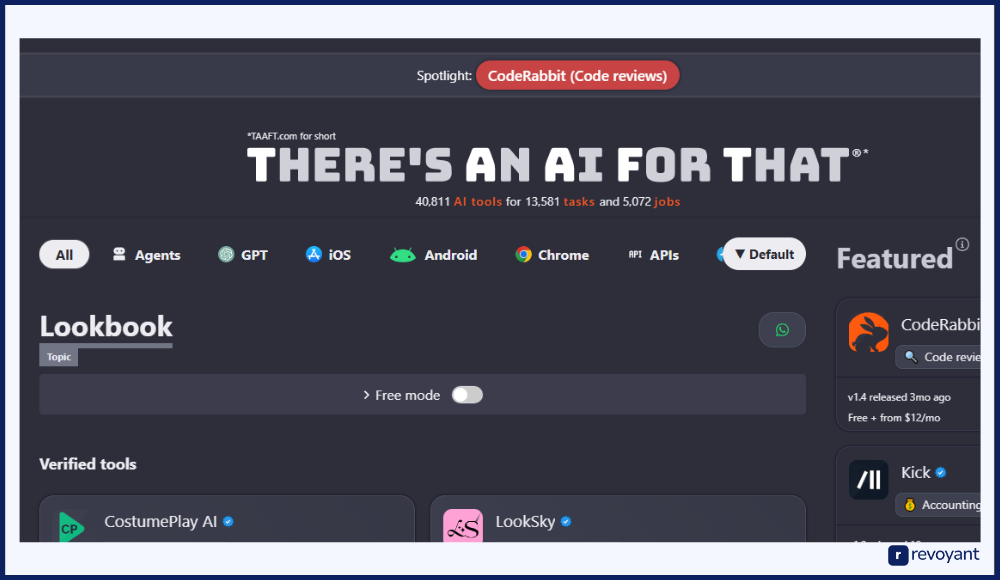
Who Should Use an AI Lookbook? (Top Use Cases in 2025)
AI lookbooks are designed for anyone who wants to feel more confident about their style without overthinking their wardrobe.
These tools are helpful whether you’re streamlining your closet, trying new looks, or just looking for a more efficient way to get dressed. Here’s how different people can benefit:
- Busy professionals who don’t have time to plan outfits every morning. With an AI lookbook, you can get daily suggestions that fit your calendar, dress code, and style without wasting time standing in front of the mirror.
- Minimalists who prefer a smaller wardrobe but want fresh combinations. AI can help make the most out of fewer items, suggesting new outfit pairings you might not have thought of on your own.
- Fashion explorers who love experimenting with trends, styles, or aesthetics. Whether you’re trying streetwear, vintage, or minimalist looks, the AI gives you ideas that align with your taste while pushing it just enough to stay current.
- Content creators and influencers who need visual consistency and outfit variety. These tools offer curated inspiration that can help build a cohesive feed while avoiding repetition.
- Travelers who want to pack smart and stay stylish. Some AI lookbooks let you filter outfits by destination, weather, or activity, making it easier to plan a trip without overpacking.
- Anyone going through lifestyle changes, like a new job, shifting body type, or moving to a different climate. AI styling tools can help you adapt your wardrobe without starting over from scratch.
No matter your lifestyle or fashion level, AI lookbooks are built to meet you where you are and help you feel more put together, every day.
Best AI Lookbook Tools in 2025: Pricing & Features Compared
With AI reshaping how we plan and style outfits, a range of tools now offer smart, personalized fashion experiences, but pricing and features vary widely.
Some are ideal for individuals looking for quick outfit ideas, while others cater to professionals, influencers, or e-commerce brands needing high customization. Here’s a quick comparison of top AI lookbook tools in 2025, including what they cost and what you get.
| Tool | Starting Price | Key Features |
|---|---|---|
| LookBook AI | $5 (one-time) | HD images, basic lookbook generation, up to 30 images |
| StyleAI | Free / $15 per month | Custom outfit design, style variations, brand-focused collections |
| 3DLOOK | $499 per month | 3D body scanning, 80+ measurements, personalized fit data |
| Stylla | Free | AI model image generation, Shopify integration |
| VirtuLook | Free trial / $29.99 per month | Fashion model generation, outfit customization tools |
Key Features to Look for in AI Lookbooks in 2025
Choosing the right AI lookbook means finding one that does more than suggest clothes. A great tool fits your lifestyle, reflects your style preferences, and actually helps you get dressed faster, with more confidence.
Below are the key features that matter most when making a decision.
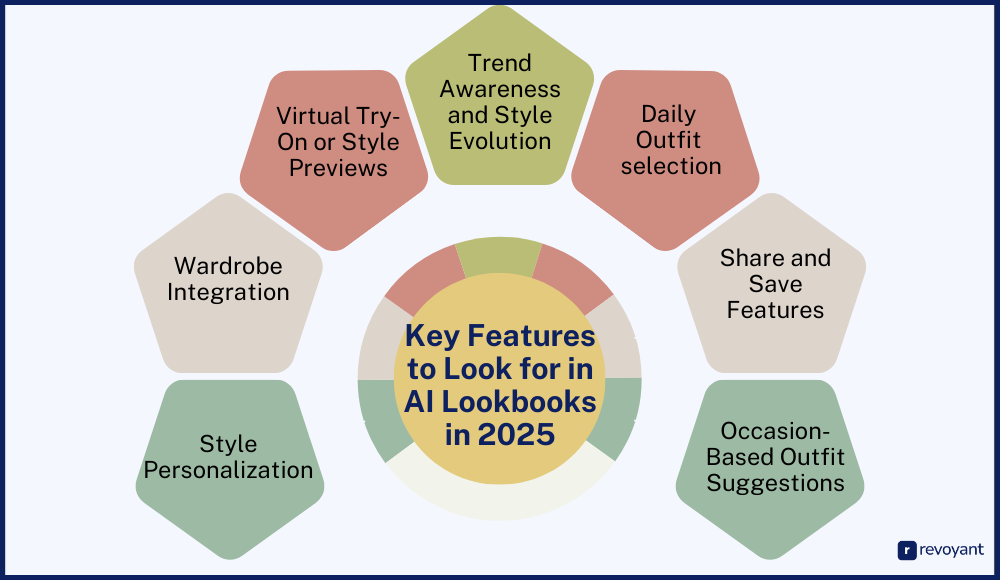
Style Personalization
Style personalization is what makes an AI lookbook feel like it’s designed just for you. This feature allows the tool to learn your preferences through quizzes, image uploads, or past shopping data. It recognizes your go-to colors, favorite fits, preferred fabrics, and even subtle style patterns. Over time, it fine-tunes its recommendations so that the looks feel more “you” with each use.
Some platforms even allow mood-based input, which lets you express how you want to dress today versus how you dressed last week. The best tools adapt as your style evolves, offering suggestions that grow with your taste rather than boxing you into one look. It’s the digital equivalent of a stylist who really pays attention.
Occasion-Based Outfit Suggestions
Not every outfit fits every situation, and a smart AI lookbook knows the difference. This feature lets you filter outfit suggestions based on the context—such as work, casual outings, gym, travel, date nights, or formal events. It brings relevance to each recommendation, helping you dress appropriately while still looking stylish.
Some advanced tools go a step further by syncing with your digital calendar, so your daily outfit suggestions reflect what you actually have planned. Whether you’re going from a morning meeting to an evening dinner, the AI adjusts accordingly. This kind of versatility means less planning, fewer mistakes, and more confidence in how you show up.
Wardrobe Integration
Wardrobe integration connects your actual clothing items with the AI’s outfit suggestions. This means the tool can work with what you already own rather than recommending entirely new purchases. You can usually upload photos of your clothes or sync with wardrobe management apps. The AI then analyzes your collection and finds fresh combinations you may not have considered.
This helps you avoid unnecessary shopping while maximizing what’s already in your closet. Some tools even highlight gaps—like missing basics or seasonal pieces—so you can shop strategically instead of impulsively. It’s a great way to reduce waste and get more value from every item you own.
Virtual Try-On or Style Previews
This feature adds a visual element that takes the guesswork out of styling. Virtual try-on tools let you see how an outfit might look on you, using avatars, AR, or flat-lay previews. Some apps let you create a digital version of yourself to try different looks in real time.
While the tech isn’t always perfect, it’s incredibly useful for visualizing how pieces work together or how they fit your body type. This makes shopping online easier and helps avoid returns. It also boosts confidence in trying new styles you might be unsure about. Even a flat preview of an outfit can help users feel more certain in their choices.
Trend Awareness and Style Evolution
Fashion is always moving, and a strong AI lookbook keeps you updated without overwhelming you. This feature pulls from trend data and blends it with your style profile to offer timely, relevant suggestions. So even if you’re not actively following trends, your outfits stay current. Some tools update seasonally or based on influencer data, while others track what people with similar styles are wearing.
Over time, the AI may gently shift your look by suggesting modern alternatives to your favorites. This helps your style evolve naturally, rather than becoming outdated or repetitive. It’s especially helpful for users who want to stay stylish but don’t have time to research trends themselves.
Daily Outfit Recommendations
One of the most practical features, daily outfit suggestions help take the stress out of your morning routine. The AI considers factors like the weather, your planned activities, and your past outfit history to recommend what to wear that day. Some tools allow you to schedule outfits in advance, plan weekly looks, or even log how you felt in each outfit for future recommendations.
It’s a simple but powerful way to build a consistent style with minimal effort. Over time, it also helps you identify your most-worn pieces, spot patterns, and make smarter clothing choices. This feature turns getting dressed into a smoother, more intentional habit.
Share and Save Features
Saving and sharing features make your lookbook more interactive and functional. You can bookmark favorite outfits, build weekly plans, or create moodboards from your past looks. Sharing outfits with friends or followers is also easy, whether you want feedback, inspiration, or just want to show off a great look.
Some apps allow community interaction, where users can rate or remix each other’s outfits. It adds a social dimension that can be helpful for creators, stylists, or anyone who likes collaborative fashion planning. Even if you prefer to keep things private, having a saved archive helps track your style over time and avoid outfit repetition.
Pros and Cons of AI Lookbooks: Is It Right for Your Style Routine?
If you’re thinking about trying an AI lookbook, it’s helpful to weigh the real benefits against a few practical limitations. These tools are built to make getting dressed easier, but like any software, they’re not one-size-fits-all. Here’s a side-by-side look at what to expect:
| Pros | Cons |
|---|---|
| ✓ Saves time by offering ready-made outfit suggestions | ✕ Style accuracy varies depending on the platform |
| ✓ Learns and adapts to your personal style over time | ✕ Initial setup (quizzes, wardrobe upload) can be time-consuming |
| ✓ Maximizes use of your existing wardrobe | ✕ Needs regular use to improve recommendation quality |
| ✓ Suggests new outfit combinations you might not think of yourself | ✕ Virtual try-ons may not perfectly reflect real-life fit or look |
| ✓ Offers occasion-specific and seasonal outfit planning | ✕ Some users may become over-reliant and stop developing personal style |
| ✓ Suitable for both beginners and fashion enthusiasts | ✕ Certain tools may lack flexibility for more niche or eclectic styles |
| ✓ Seamless shopping options built into some platforms | ✕ Not all platforms offer robust customer support or updates |
How to Start Using an AI Lookbook in 2025: Step-by-Step Setup Guide
If you’re ready to try AI to simplify your outfit planning or elevate your style, getting started is simple. Most AI lookbook tools are user-friendly and designed to adapt to your needs.
Here’s a step-by-step guide to help you get the most out of your experience from day one.

Step 1: Choose a Platform That Matches Your Goals
Start by picking a tool that fits your needs, style preferences, and budget. If you’re just experimenting, a free version or a tool with a one-time payment is a great way to test things out. If you’re a content creator, business owner, or want high customization, go for a platform with premium features.
Review user interfaces, check available features (like virtual try-ons or closet integration), and read current reviews to compare options. Some tools focus on visual outfit planning, while others are designed for fashion e-commerce or body scanning. Choose based on how hands-on or automated you want the experience to be.
Step 2: Create Your Style Profile
Once you’ve picked a platform, it will usually prompt you to set up a profile. This is where you help the AI understand your fashion preferences. You may be asked to:
- Complete a short quiz about your style, favorite colors, fits, and brands
- Upload photos of outfits you like or items you already own
- Connect your shopping history from certain retailers or apps
The more detail you provide here, the more accurate and useful your outfit suggestions will be. A good style profile lays the groundwork for consistently relevant recommendations.
Step 3: Upload Your Wardrobe (Optional but Valuable)
Some AI lookbooks allow you to upload photos of the clothing items you already own. This step is optional on some platforms, but it’s extremely helpful. By seeing what’s actually in your closet, the AI can create personalized outfit ideas using what you have, not just suggesting what to buy.
You can usually take quick photos with your phone and tag items by type (e.g., jeans, jackets, shoes). This feature is especially useful if you want to build a capsule wardrobe, reduce waste, or get more creative with fewer items. It turns the AI into a true wardrobe assistant.
Step 4: Start Generating Outfit Ideas
After your profile and wardrobe are set, the AI begins creating tailored outfits. These suggestions can be based on your preferences, the weather, or even upcoming events. Many platforms let you browse outfits by occasion (work, date night, casual, etc.), and some update daily to keep things fresh.
You can like, save, or dismiss suggestions to help the system learn what you love. Some tools offer moodboards or drag-and-drop builders so you can edit or remix outfits. This step is where the fun begins — you’ll start seeing combinations you may have never tried.
Step 5: Use It Regularly to Maximize Value
To get the best results, use your AI lookbook consistently. The more you engage with the tool, the more it learns and refines its suggestions. Regular use also helps you track your style habits, repeat favorite looks, and stay organized.
- Plan outfits ahead for events, travel, or photoshoots
- Use it daily to reduce outfit indecision in the morning
Think of it as your digital stylist — the more you check in, the smarter and more helpful it becomes.
Step 6: Upgrade or Customize As Needed
Most platforms offer free tiers, but you can unlock more features by upgrading. If you find value in what the AI is delivering, consider going premium to access perks like high-resolution downloads, more outfit slots, or virtual try-on features.
Paid plans often include integrations with e-commerce, advanced style analytics, or team access for creators and brands. If you’re using it for content creation, marketing, or personal styling services, the extra tools can be well worth it. Start with free, and upgrade when you feel the base experience is no longer enough.
Top Alternatives to AI Lookbooks for Smarter Outfit Planning in 2025
Not every fashion lover wants to rely on AI-generated outfits alone — and that’s perfectly fine. Whether you prefer more control, a human stylist, or visual inspiration boards, there are plenty of tools that help you manage your wardrobe, plan outfits, and refine your personal style.
Below are the top alternatives to AI lookbooks, each offering a unique way to stay stylish and organized without needing a full AI system.
Whering
Whering is a digital wardrobe and outfit planning app that helps users organize their clothing, plan outfits in advance, and get the most out of their existing wardrobe. By uploading photos of your clothes, you create a virtual closet that becomes the foundation for smart, personalized outfit suggestions.
The app is built for people who want to save time, avoid outfit repetition, and develop a more sustainable relationship with fashion. Whether you’re building a capsule wardrobe or just want help rotating your clothes creatively, Whering gives you the tools to do it with ease. Its clean, mobile-friendly interface and AI-based outfit ideas make it ideal for daily use.
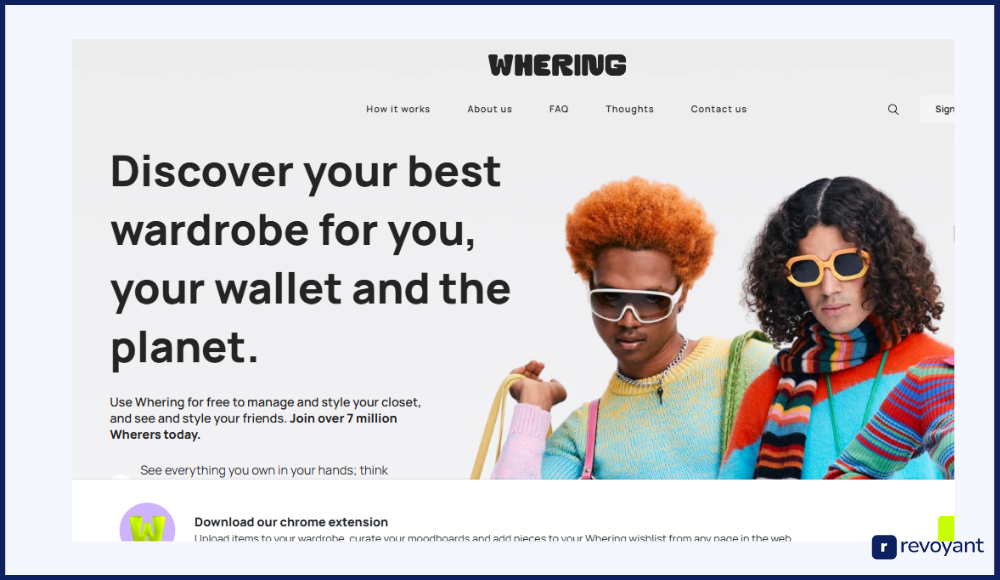
Whering Pricing
Whering is completely free to use, with no hidden charges or required upgrades. All of its essential tools — including wardrobe uploads, outfit suggestions, and planning features — are available without cost. A premium plan is reportedly in development, but has not yet launched.
- Free to use with full access to wardrobe planning tools
- No in-app purchases or locked content in the core version
- Premium subscription with advanced features is planned for future release
Key Features of Whering
Whering offers a full suite of wardrobe and outfit planning tools designed to make your closet more functional and your style more intentional.
- You can upload your entire wardrobe by snapping photos of your clothes, which the app automatically categorizes by item type, season, and color for easy browsing.
- It generates personalized outfit suggestions every day based on factors like weather, calendar events, and your past outfit choices, helping you get dressed faster with less stress.
- The app includes a planner where you can schedule outfits for upcoming days, events, or trips, allowing you to pack or prep in advance without overthinking it.
- You receive wardrobe usage insights that show which items you wear most and least often, encouraging smarter, more sustainable shopping habits and better use of what you already own.
- Whering also lets you save outfits and build custom moodboards, which you can use for style inspiration, seasonal planning, or creating content if you’re a fashion-focused user.
Pros and Cons of Whering
Whering delivers excellent value as a free tool, especially for users focused on sustainability, organization, and daily outfit planning. However, like any app, it has trade-offs depending on how visual or advanced you want your styling features to be.
| Pros | Cons |
|---|---|
| ✓ Free to use with no required upgrades | ✕ No virtual try-on or 3D visualization features |
| ✓ Makes your wardrobe easier to manage and categorize | ✕ Requires time upfront to photograph and organize your clothes |
| ✓ Offers daily outfit ideas based on what you own | ✕ Outfit suggestions may be limited if wardrobe photos are unclear or missing categories |
| ✓ Helps reduce unnecessary shopping with wardrobe usage insights | ✕ Interface may feel limited for advanced or professional styling needs |
| ✓ Includes planning tools for events, travel, and weekly outfits | ✕ Premium tier not yet available, so advanced features are pending |
Acloset
Acloset is an AI-powered smart closet and outfit planning app designed to help users get the most out of their wardrobe. It lets you upload clothing, automatically organizes it, and offers personalized daily outfit suggestions based on season, weather, and your personal style.
The app also tracks how often you wear each item and helps you plan outfits for specific events or trips. It’s particularly useful for people looking to simplify decision-making while still enjoying variety in what they wear. Acloset combines smart features with a clean, easy-to-use interface that works well for both minimalists and fashion lovers alike.
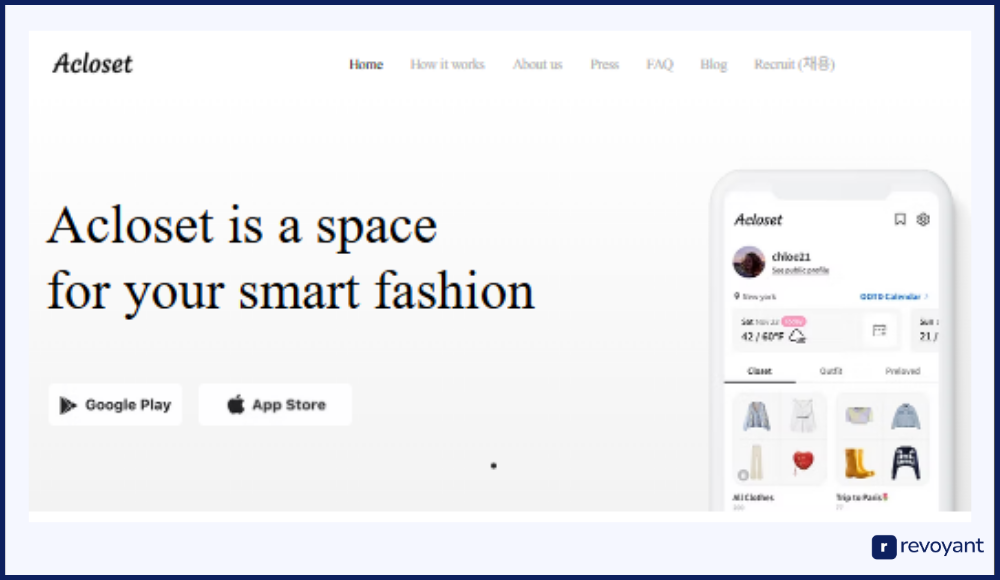
Acloset Pricing
Acloset is free to download and use, with full access to wardrobe digitization and outfit planning.
There are no required subscriptions or in-app purchases for core functionality.
Premium features may be introduced later, but as of now, the app is fully functional without payment.
- Free to use with full wardrobe and outfit features
- No subscription or paid tiers required
- Future premium features may be optional
Key Features of Acloset
Acloset allows you to upload photos of your clothes, which are automatically scanned and categorized using AI, saving time during the setup process.
- The app provides daily outfit suggestions tailored to your wardrobe, the current season, and weather, so you don’t have to think about what to wear.
- You can plan and schedule outfits in advance using a built-in calendar, which is perfect for travel, events, or weekly wardrobe prep.
- Acloset tracks wardrobe statistics such as frequency of wear, helping you identify which pieces you love versus what’s sitting unused.
- It also features a community tab where users can share and explore outfit ideas from others, adding an element of style inspiration and social sharing.
Pros and Cons of Acloset
Acloset offers an impressive mix of wardrobe analytics and smart outfit planning, but lacks more immersive visual features like try-ons or avatars.
| Pros | Cons |
|---|---|
| ✓ Free to use with automated wardrobe organization | ✕ No virtual try-on or augmented reality support |
| ✓ Fast setup with auto-detection of clothing type and color | ✕ Some items may need manual editing after upload |
| ✓ Offers season- and weather-aware outfit recommendations | ✕ Outfit suggestions may seem basic without regular use |
| ✓ Tracks wear frequency to help you make informed shopping choices | ✕ App interface can get cluttered with large or detailed wardrobes |
| ✓ Built-in calendar for trip and event outfit planning | ✕ Limited options for shopping integration or brand recommendations |
Cladwell
Cladwell is a capsule wardrobe and outfit planning app designed to help you simplify your style and make the most out of a small, intentional collection of clothing. Unlike many fashion apps, Cladwell encourages thoughtful, minimalist dressing.
It doesn’t rely on AI-generated outfits from new purchases but instead uses the clothing you already own to generate daily look suggestions. It’s perfect for people who want to reduce clutter, save money, and still look put-together. With its focus on intentional styling, Cladwell is especially popular among users trying to live with less while dressing with more purpose.

Cladwell Pricing
Cladwell offers a free trial for new users so you can test the experience.
Full access requires a subscription, which unlocks all wardrobe planning features and daily outfit recommendations.
It’s priced for individuals who want a personal styling tool without shopping integrations or advertising.
- Free 7-day trial for first-time users
- Monthly plan around $5/month (may vary slightly by region)
- Annual plan offers a small discount over monthly billing
Key Features of Cladwell
Cladwell focuses on simplifying how you get dressed by helping you build a capsule wardrobe and make the most of what you already own. It’s ideal for users who want daily outfit suggestions without needing to follow trends or constantly buy new clothes.
- The interface is ad-free and clean, which makes it easy to focus on your wardrobe goals without distractions or upsells.
- You can build your digital wardrobe by selecting items that match what you already own from Cladwell’s visual catalog, focusing on staples rather than trendy pieces.
- The app provides daily outfit suggestions using only the items in your wardrobe, giving you new ways to wear your clothes without encouraging new purchases.
- Outfit ideas are personalized based on your lifestyle, weather, and calendar, so the suggestions are both practical and wearable every day.
- You can track how often you wear each item, helping you stay aware of wardrobe usage and identify what’s worth keeping or letting go.
Pros and Cons of Cladwell
Cladwell is one of the best tools for people who value simplicity, minimalism, and wardrobe sustainability, though it may feel limited for trend-seekers or users with large, diverse closets.
| Pros | Cons |
|---|---|
| ✓ Focuses on intentional dressing and capsule wardrobes | ✕ Requires a subscription after the trial period |
| ✓ Provides personalized daily outfit suggestions without shopping pressure | ✕ Doesn’t include advanced AI or auto wardrobe detection |
| ✓ Encourages smarter use of clothes you already own | ✕ No support for photo uploads — you choose from basic item templates |
| ✓ Tracks clothing usage to help reduce waste and repetitive outfits | ✕ Limited styling features for fashion-forward or experimental users |
| ✓ Clean interface with no ads or fast-fashion content | ✕ Lacks community or social outfit inspiration features |
Stitch Fix
Stitch Fix is a personal styling service that blends human expertise with data-driven recommendations to deliver curated clothing directly to your door. Instead of browsing through endless items online, you simply fill out a style profile, and a professional stylist sends you a customized box of clothes based on your size, preferences, and budget.
You try everything on at home, keep what you like, and send back what you don’t. Stitch Fix is ideal for people who want personalized fashion advice without spending time shopping. It’s especially useful for busy professionals, new wardrobe builders, or anyone looking to refresh their look with expert help.
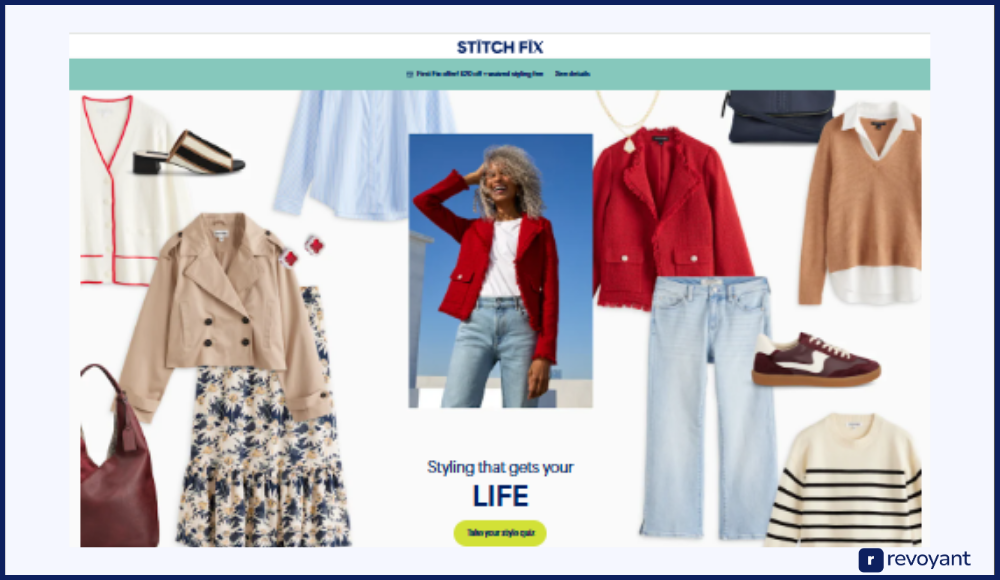
Stitch Fix Pricing
Stitch Fix charges a flat styling fee for each box, which is credited toward any item you decide to keep. There’s no subscription required, so you can order on-demand or set a delivery frequency. Prices for clothing vary but are typically aligned with mid-range retail brands.
- $20 styling fee per Fix (waived if you keep an item)
- Clothing typically ranges from $40 to $200 per piece
- No subscription required; use as often or as little as you want
Key Features of Stitch Fix
Stitch Fix pairs you with a real human stylist who reviews your preferences, sizes, and feedback to select pieces that truly match your style.
- The platform uses data science and algorithms to support the stylist’s decisions, ensuring recommendations align with your fit, price range, and personal taste.
- You receive a physical box with 5 items to try on at home, making the shopping experience more convenient and less pressured.
- The service allows you to leave detailed feedback on each item, so your future Fixes become more personalized over time.
- Stitch Fix includes options for men, women, plus-size, petite, maternity, and even kids — making it accessible for nearly everyone.
Pros and Cons of Stitch Fix
Stitch Fix offers a highly personalized styling experience with real human insight, though it may not appeal to users who prefer full control over what they see and buy.
| Pros | Cons |
|---|---|
| ✓ Provides expert, human-curated clothing selections | ✕ Styling fee applies even if you return all items |
| ✓ No subscription required — fully on demand | ✕ You don’t get to choose specific items before they ship |
| ✓ Saves time by delivering clothing directly to your door | ✕ Price points may be higher than fast fashion or online deals |
| ✓ Easy returns and only pay for what you keep | ✕ Not ideal for those who prefer browsing or choosing outfits themselves |
| ✓ Offers wide sizing and style inclusivity | ✕ Limited to countries where Stitch Fix operates |
Pinterest is a visual discovery platform used by millions to collect, organize, and get inspired across categories like fashion, design, and lifestyle. It’s not a traditional wardrobe tool, but it’s one of the most powerful ways to explore outfit ideas and discover styles you might not find elsewhere.
Users create boards, pin their favorite outfits or styling tips, and gradually build a personal style reference. Whether you’re curating a lookbook for a season, event, or just refining your aesthetic, Pinterest acts like your virtual moodboard. It’s especially helpful for people who want to gather ideas visually before applying them to their real wardrobe.
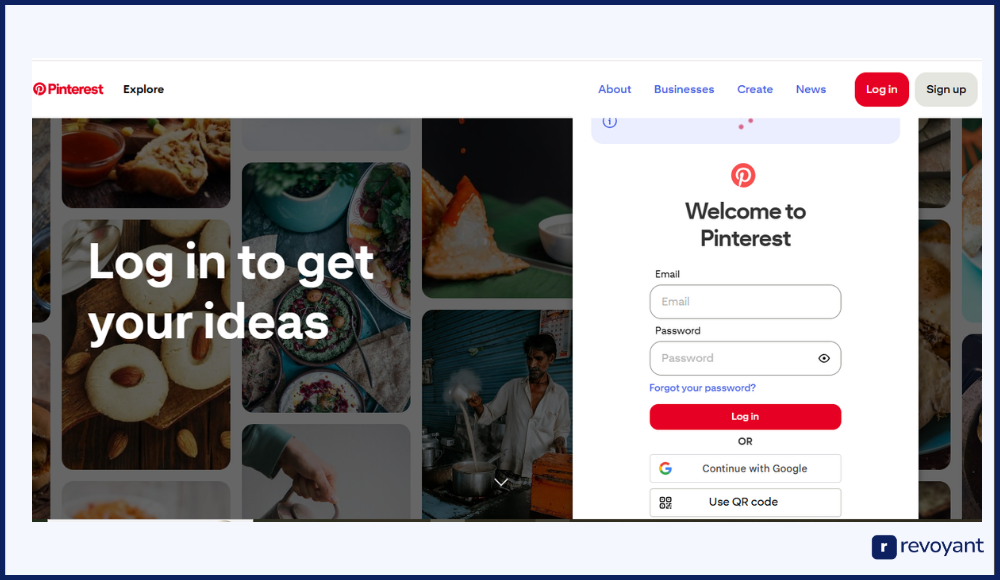
Pinterest Pricing
Pinterest is entirely free to use for all features. There are no subscriptions, fees, or required upgrades. It monetizes through promoted pins (ads), which users can ignore or explore.
- 100% free to browse, pin, and save outfits
- No paid tiers, upsells, or membership costs
- Optional shopping links from some pins, but purchases are not required
Key Features of Pinterest
Pinterest is a powerful tool for visual style discovery and personal expression, making it a top alternative for users who prefer to self-curate their fashion inspiration.
- You can search for fashion-related keywords (like “spring outfits” or “capsule wardrobe”) and instantly see thousands of real outfit ideas, organized by relevance.
- The platform lets you create custom boards where you save pins — giving you a personalized style archive you can revisit and expand over time.
- It supports rich visual content including photos, infographics, and how-to guides, which can help you plan looks, follow trends, or build outfits from scratch.
- Pinterest’s algorithm suggests new pins based on your behavior, helping you discover fresh ideas that match your style even if you’re not sure what to search for.
- You can follow fashion influencers, stylists, or brands to stay updated on the latest outfit inspiration, and even shop directly from select pins if you choose.
Pros and Cons of Pinterest
Pinterest is ideal for visual learners and fashion planners, though it doesn’t offer AI, outfit generation, or personal closet management features.
| Pros | Cons |
|---|---|
| ✓ Completely free with unlimited access to outfit ideas | ✕ Does not offer wardrobe planning or outfit scheduling tools |
| ✓ Allows you to create custom style boards and save looks you love | ✕ No AI or automation — entirely manual and user-driven |
| ✓ Great for trend discovery, visual planning, and seasonal inspiration | ✕ Can feel overwhelming due to content overload and repetition |
| ✓ Helps you explore and define your personal style over time | ✕ No integration with your actual clothing or closet inventory |
| ✓ Easy to use on desktop or mobile, with strong community interaction | ✕ Some content may lead to sponsored or unavailable products |
AI Lookbook Tools vs Other Tools: Which Is Best for Your Style Goals?
Choosing the right outfit planning tool depends on how much control, personalization, and automation you want. This comparison table gives you a side-by-side view of AI lookbooks and their top alternatives — from fully automated styling apps to hands-on planners and human-curated services. Use it to quickly see which platform fits your budget, style goals, and wardrobe management needs.
| Tool | Type | Price | Outfit Suggestions | Wardrobe Upload | AI-Powered |
|---|---|---|---|---|---|
| AI Lookbooks | AI outfit generator | Free–$99/month (varies) | Yes | Sometimes | Yes |
| Whering | Wardrobe + outfit planner | Free | Yes | Yes | Yes |
| Acloset | Smart wardrobe manager | Free | Yes | Yes | Yes |
| Cladwell | Capsule wardrobe planner | ~$5/month (after trial) | Yes | Template-based | No |
| Stitch Fix | Personal styling service | $20 per box + item costs | Yes | No | Assisted |
| Visual moodboard platform | Free | No | No | No |
Why AI Lookbooks Are the Smartest Way to Style Your Wardrobe in 2025
AI lookbooks are built for modern users who want personalized, time-saving fashion solutions without the overwhelm. Whether you’re managing a digital wardrobe, planning for an event, or just want outfit ideas that make sense for your life, AI lookbooks offer a smart, efficient way to stay stylish. Here are the top reasons to choose one.
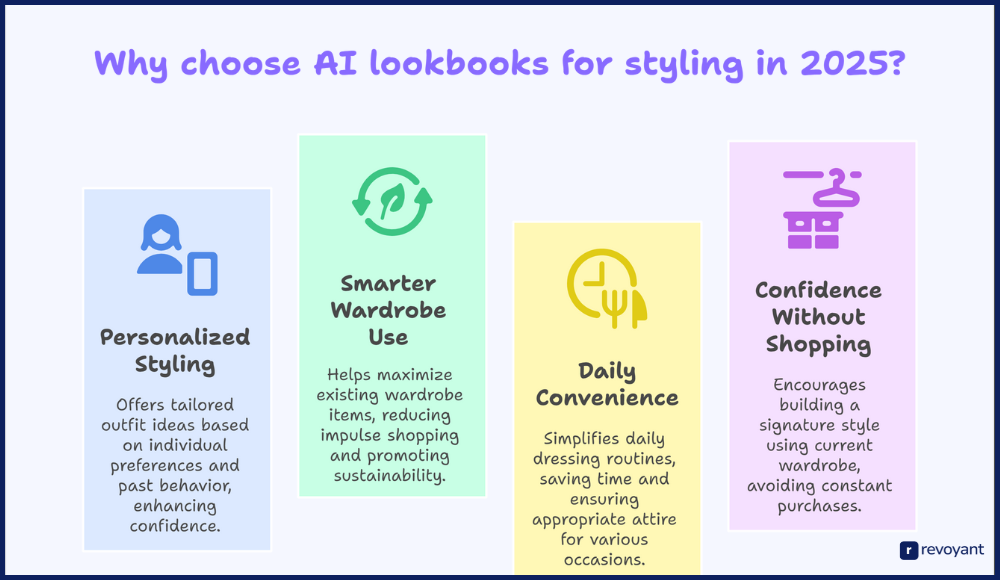
Personalized Styling Without the Guesswork
AI lookbooks use data from your clothing, preferences, and past behavior to generate outfit ideas that actually match your style. Instead of relying on broad trends or generic advice, the system learns what colors, cuts, and combinations work for you. Over time, suggestions get more accurate, helping you feel more confident in what you wear.
This kind of personalization used to be reserved for expensive human stylists. Now, it’s available right on your phone. For anyone who wants to express their individuality without spending hours planning looks, AI is the ideal shortcut.
Smarter Wardrobe Use
One of the biggest advantages of AI lookbooks is that they help you make better use of what you already own. By mixing and matching your clothes in ways you might not think of, the tool essentially gives you a fresh perspective on your closet.
It reduces the need for impulse shopping and helps you rediscover underused pieces. Some tools even track wear frequency or suggest items that complete your existing outfits. Over time, this leads to a more efficient, sustainable wardrobe. You’re not just dressing better. You’re buying and wasting less.
Daily Convenience and Time Savings
Getting dressed becomes easier when an AI lookbook is part of your routine. You wake up, check your suggested look, and you’re ready to go. Some platforms factor in your calendar, weather, and occasion to offer context-aware recommendations so you’re not just stylish, you’re appropriately dressed for your day.
This is especially helpful for busy mornings, travel prep, or days when you don’t want to think too hard about what to wear. Instead of wasting 15 minutes in front of your closet, AI cuts that decision down to seconds.
Confidence Without Constant Shopping
AI lookbooks give you styling support without pushing you to constantly buy new clothes. Many tools are designed to work with your existing wardrobe, encouraging smarter use of what you already have. This makes it ideal for people who want to build a signature style or stick to a minimalist mindset.
You still get fresh, updated looks but they come from what’s real in your closet, not from fast fashion ads. That means fewer regrets, fewer returns, and more outfits you actually feel good in.
Expert Tips to Maximize Your AI Lookbook Results
- Take time to set up your style profile honestly. The more accurate your preferences and wardrobe uploads, the better your outfit suggestions will be.
- Use filters like weather, occasion, or color to tailor your lookbook results and avoid generic recommendations.
- Check in regularly to rate outfits and save favorites — this helps the AI learn faster and improve its suggestions.
- Combine AI with your own creativity. Use suggested outfits as a base, then tweak them to reflect your mood or accessories.
- If you’re building a capsule wardrobe, use AI lookbooks to spot your most-used items and identify what you’re actually missing.
Final Thoughts: Should You Use an AI Lookbook in 2025?
AI lookbooks are more than just trend-driven apps. They’re practical, personalized tools for anyone who wants to get dressed faster, smarter, and with more confidence. Whether you’re trying to simplify your routine, refresh your style, or make better use of the clothes you already have, these platforms can make a real difference.
If AI isn’t the right fit, there are great alternatives like Whering, Acloset, or Stitch Fix that offer similar benefits through different formats. The key is finding a tool that works for your lifestyle and helps you feel good in what you wear every single day.
AI Lookbooks FAQ: Answers to Common Styling Questions in 2025
What is an AI lookbook and how does it work?
An AI lookbook is a digital styling tool that uses artificial intelligence to generate outfit suggestions based on your wardrobe and preferences. It creates personalized combinations for different occasions or everyday use.
Do I need to upload my entire wardrobe for it to work?
Some tools work best with wardrobe uploads, but others use templates or sample closets. The more you upload, the more tailored your results will be.
Are AI lookbooks free to use?
Some platforms are completely free, while others offer premium features for a subscription or one-time fee.
Can AI lookbooks help me shop smarter?
Yes, they help you style what you already own and identify what’s missing, so you avoid unnecessary shopping.
Are AI lookbooks better than using Pinterest or a personal stylist?
AI lookbooks are faster and more automated than a human stylist, and easier to manage than manually saving outfit ideas on Pinterest.





